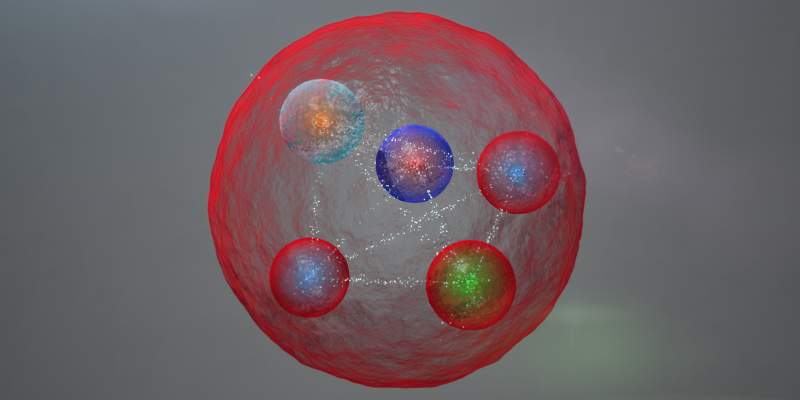
From Rosetta’s ongoing love affair with a comet and the discovery of a pentaquark, to controversial breakthroughs like gene-editing of human embryos and a possible new species of homo sapiens, these were the science stories everyone was talking about in 2015.
Rosetta and Its Potato-Shaped Comet
The European Space Agency’s Rosetta mission to explore Comet 67P/Churyumov-Gerasimenko was the science-y gift that kept on giving in 2015, particularly its slew of eye-popping images to delight space porn enthusiasts everywhere. It started in January
As the year progressed, we got stunning new photos from a low-altitude flyby
[Note: Pluto was also very big news in 2015—so much so that we’re giving everyone’s favorite dwarf planet a list all its own. Look for it this week.]

Illustration of a pentaquark particle. Credit: CERN.
The LHC Discovers a Pentaquark
The new improved Large Hadron Collider wasted no time getting down to business this year: its LHCb experiment promptly discovered a new class of subatomic particles
The first evidence for a possible pentaquark appeared in 2002 at the Spring-8 synchrotron in Harima, Japan, and initial re-analysis of the data strengthened the case. But by 2005, physicists had concluded it wasn’t a real signal, and for the last decade, the pentaquark has frequently been cited as an example of how easy it is to see something in the data that isn’t really there. Now we know the pentaquark actually exists, although the LHCb pentaquark is different from the one supposedly seen in 2002 (it’s three times heavier and contains different kinds of quarks). Still, it sets the scene for exciting new developments to come. As MIT’s Frank Wilczek, one of the architects of the theory that describes the forces holding quarks together, told Nature: “It’s like a phoenix rising from the ashes.”

Skeletal fossils of the hand of homo naledi. Credit: John Hawks/Wikimedia Commons
Possible New Species of Homo Sapiens
The excitement was palpable when researchers from University of the Witwatersrand in Johannesburg uncovered 15 partial skeletons
But the find proved controversial

Credit: Wellcome Images.
Gene-Editing of Human Embryos
Following weeks of speculation, news broke earlier this year
Frankly, the paper itself proved problematic: it was rejected by both Nature and Science, on ethical grounds, and ultimately published by Protein and Cell. But its broader impact was undeniable, motivating some of the world’s leading geneticists and bioethicists to convene an International Summit on Gene Editing several weeks ago. The subsequent report laid out
One Step Closer to a Universal Flu Shot
Flu shots change with the seasons, because there are so many different strains; the shots must be tailored to whichever strains are dominant in any given year, based on the shapeshifting decoy proteins that line the virus’s surface. By putting those decoy proteins in our vaccines, we prime our immune systems against the flu. But now we’re one step closer to a universal flu shot

The iChip, used to discover the first new antibiotic in 30 years. Credit: Slava Epstein.
First New Antibiotic in 30 Years
Antibiotic resistance is on the rise among bacteria like MRSA. So the announcement that scientists had found the first new class of antibiotics

Krister Shalm adjusts the photon source in his Bell test experimental set-up. Credit: Burrus/NIST
Spooky Action at a Distance Is Real
Dubbed “spooky action at a distance” by Albert Einstein, entanglement is a quantum phenomenon whereby two subatomic particles can be so closely connected that one can seem to influence the other even across long distances. Three independent experiments this year have definitively shown
Physicists have been conducting variations of the so-called Bell test for decades with greater and greater precision, but could never quite claim to have produced definitive proof of spooky action, because there were still critical loopholes in the experimental design. Until quite recently, they simply didn’t have sufficiently advanced technology to close those loopholes.
Earlier this year, physicists at Delft University of Technology in the Netherlands sent two entangled electrons to separate corners of the campus and found that spooky action was real. Krister Shalm and his colleagues at the National Institute of Standards and Technology in Colorado closed those loopholes with greater precision than ever before, hammering the final nail in local realism’s coffin. A second team of physicists at the University Vienna conducted yet another version of the Bell test using one of NIST’s single photon detectors. They reported similar results, submitting their own paper to the journal Physical Review Letters at the same time as Shalm and his co-authors. Taken together with the Delft results, these loophole-free Bell tests should settle the question once and for all.
Mind-Melds With Rats and Monkeys
Star Trek fans are well familiar with Spock’s proficiency with the Vulcan mind-meld. But neuroscientists say something similar really does happen when brains are electrically linked to share impulses across a network. Two studies published
Duke University researchers led by neuroscientist Miguel Nicolelis implanted two sets of electrodes in the brains of four rats and gave them a pattern recognition test to “solve.” Through trial and error, they found that the rats figured out to synchronize their brain signals. They acted in concert as a simple computer. The Duke team had similar results when they rigged up monkeys with brain-computer interfaces (BCIs). The three brain-linked monkeys were able to coordinate their efforts to manipulate a robotic arm. It’s still not Spock-worthy mind-melding, but it’s an exciting advance on the neuroscience front nonetheless.
Top image: New shape model of Comet 67P/Churyumov-Gerasimenko. Credit: ESA.